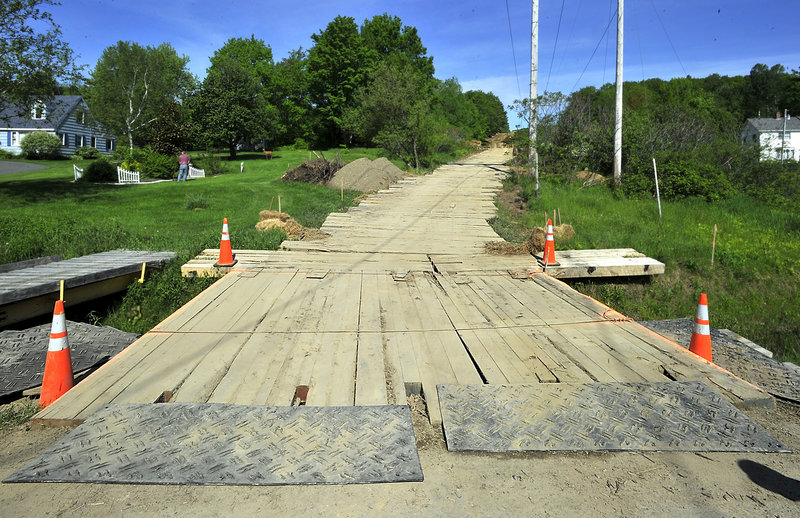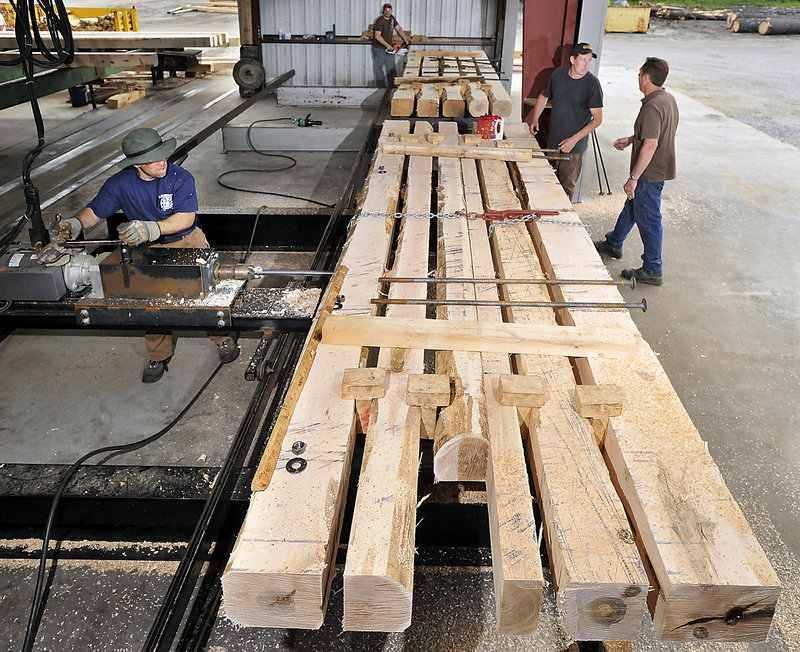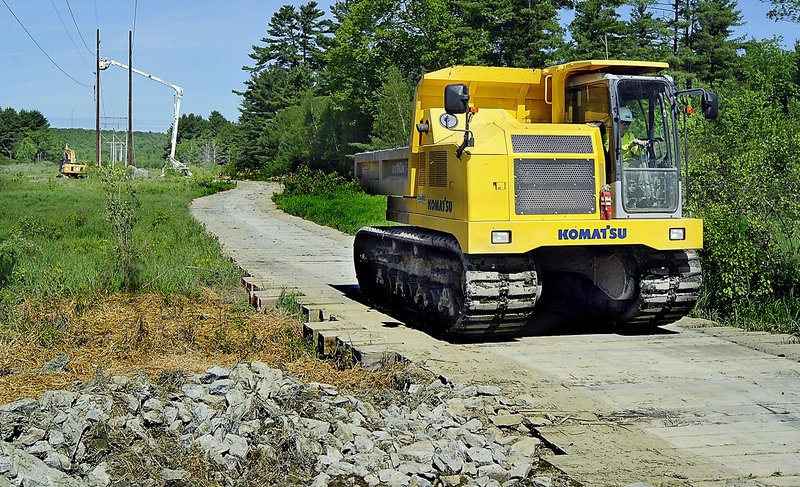AUGUSTA – It’s not unusual to see bucket trucks setting utility poles in Maine during the construction season. It’s less common to see one standing a quarter-mile into a freshwater marsh.
Largely out of public view, bucket trucks, cranes and other heavy equipment are traversing Maine’s forests and wetlands this spring on temporary timber highways. They’re working on the $1.4 billion upgrade of Central Maine Power Co.’s transmission system from Orrington to Eliot.
The route covers 350 miles, and virtually every one of them contains some wetlands.
To do the job year-round without getting stuck in the muck or damaging the environment, contractors are taking a cue from Roman invaders, Civil War generals and Maine woodsmen. They are using the modern, movable version of a corduroy road.
Corduroy roads have progressed beyond logs lying perpendicular through a swamp for horses and wagons. The Maine mats are 16-foot-wide corridors of brawny hardwood, able to handle equipment that can weigh up to 50 tons.
CMP will need a lot of these stout swamp mats over the next five years, upward of 200,000. Buying and handling them is expected to cost $100 million.
The pace of energy construction across the Northeast is giving a boost this year to a small, largely unrecognized cottage industry in Maine: timber mat makers. Maine has at least five companies that manufacture timber mats, and they are busy.
“I have four or five years of work now,” said Peter Glidden, who owns Glidden Mat in Parkman, near Guilford.
Glidden has sold 10,000 mats for the Maine project, with more orders pending. He and his 13 employees also are supplying a natural gas pipeline expansion in Pennsylvania. Glidden has a contract with Bear Hill Lumber Co. in Hollis Center to help with production.
Scott Thomas, who owns Northeast Timber Mats LLC, is supplying CMP’s project from facilities in Gray and Lincoln. He figures he has steady work for the next six to 12 months.
Northeast is building roughly 150 mats a week, but Thomas said he could double production, if he could get more of the hardwood logs he needs. Hardwood also is harvested for firewood and wood pulp for paper mills.
CMP’s project has helped Maine’s small mat producers develop a relationship with the country’s largest timber mat broker, DixieMat LLC of Sandy Hook, Miss. That has created opportunities for Maine companies to ship more mats south.
Maine manufacturers have a competitive advantage, beyond geography, in supplying CMP’s project.
To limit the spread of disease-carrying insects, regulations prohibit mats from coming into Maine unless they are stripped of bark. Companies using local logs don’t need to take this extra step. But demand is so great that Maine companies can’t keep up, and mats are being shipped here from other states.
Swamp mats look basic, but they’re built to precise specifications.
Most are made of 8-inch-thick timbers of mixed hardwood, typically oak, maple and birch. Some are hemlock, which lasts longer in the mud but is tougher on tractor treads.
Each mat is 4 feet by 16 feet and weighs roughly 2,500 pounds. A handful of timbers are threaded together with steel rods to form a mat. Hundreds of mats can be stretched along a utility corridor to reach where contractors need to go.
Mat roads were strung out last week on the eastern outskirts of Augusta, where contractors were adding utility poles in wetlands near Greeley Pond. This section of the project is being built by a partnership between Pittsfield-based Cianbro Corp. and Irby Construction of Jackson, Miss.
Workers in an off-road bucket truck were attaching wires and insulators to a new pole. A track dump — a specialized dump truck with tractor treads — was hauling fill material back to the site along the utility corridor. The marsh was largely undisturbed on either side of the mats, and Andy Harris, the crew foreman on the job, said the technique is surprisingly effective.
“If these mats weren’t here, it would be a mess,” he said. “You pull these up and in a matter of a month or so, there’s vegetation growing back up.”
Harris, who works on similar projects around the country for Irby, said Maine’s requirements for minimizing erosion and protecting water quality in the utility corridors are tougher than in many other places.
“They’re doing a lot of extra protection,” he said. “There’s a lot of money in those mats.”
Each mat costs at least $400. A mile away, contractors had put down roughly a quarter-mile of them to reach six poles. One section bridged a stream. The mats will be on site for a few weeks, then removed and trucked to a new location.
Despite their heft, swamp mats suffer a lot of abuse. Mud, water and heavy equipment wear out even the best mats within five years.
When their useful lives are over, mats that helped connect power generators can themselves become a source of energy. The steel rods are removed and the timbers are ground up. The wood is burned in biomass boilers to make steam and electricity, perhaps zipping along the upgraded utility corridors they helped create.
Staff Writer Tux Turkel can be contacted at 791-6462 or at:
tturkel@pressherald.com
Send questions/comments to the editors.






Success. Please wait for the page to reload. If the page does not reload within 5 seconds, please refresh the page.
Enter your email and password to access comments.
Hi, to comment on stories you must . This profile is in addition to your subscription and website login.
Already have a commenting profile? .
Invalid username/password.
Please check your email to confirm and complete your registration.
Only subscribers are eligible to post comments. Please subscribe or login first for digital access. Here’s why.
Use the form below to reset your password. When you've submitted your account email, we will send an email with a reset code.